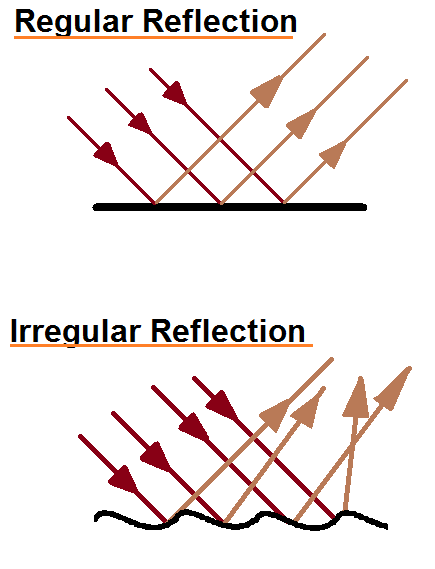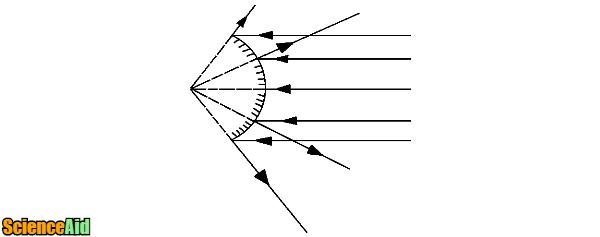Geometrical Optics and Reflection of Light
Edited by Jen Moreau, Sim, SarMal, Sharingknowledge
Geometrical Optics
Geometrical optics is also known as ray optics. Using the term rays geometrical optics approximate the paths light travels. Rays are used to define the movement of light depending on the environments and mediums around it. Light rays travel in a straight line until they hit a medium. Depending on the medium, the light rays may be absorbed or reflected, bend or divide or even curve if the refractive index of a medium varies (such as water).
Reflection of Light
Reflection is the process by which a light ray hits a medium and then bounces or rebounds off. The amount of reflected light depends on:
- a. The nature of the medium the light ray propagates through
- b. The color of the light ray
- c. The angle at which the light ray strikes the surface of the boundary.
Some facts about the reflection of light:
- The light ray that hits the medium is called incident ray and the ray that bounces off is termed reflected ray.
- When light falls on a plane mirror (flat mirror), about 80% of the incident light is reflected.
- A black or opaque body is a poor reflector while a white body is a good reflector.
- From a highly polished surface, nearly all the light is reflected.
Regular Reflection: (Specular reflection) is defined as reflection of light from a smooth surface.
Irregular Reflection: (Diffuse Reflection) Light rays reflecting from a rough or uneven surface is called irregular reflection or diffuse reflection.
Reflection of Light from A Plane Surface
(Plane Mirror)
- 1A ray of light is the straight line along which light travels.Ray of light:Advertisement
- 2
- 3The ray of light that bounces back from the mirror is called reflected ray. In the figure, OB is the reflected ray.Reflected Ray:
- 4The normal is the line that is perpendicular to the mirror at the point of incidence. ON is normal.Normal:
- 5The angle between the incident ray and the normal is called incident angle. In the figure, AON is the angle of incidence, denoted by 'Li'.Angle of Incidence:
- 6The angle between the reflected ray and the normal is called reflected angle. NOB is the angle of reflection, denoted by 'Lr'.Angle of Reflection:
Laws of the Reflection of Light
There are two laws that explain the reflection of light first discovered by Ibn-Ul Haitham and written in his book Kitab al-Manazir (Book of Optics) in the early 1000's [1]. These laws are as follows:
- (1) The incident ray, the reflected ray and the normal (at the point of incidence) all lie in the same plane.
- (2) The angle of incidence (Li) is always equal to the angle of reflection. (Lr) mLi = mLr
Given the laws of reflection, different types of reflective mediums are used effectively for different purposes.
Spherical Mirror
Mirror: is defined as a surface from which light undergoes regular reflection. It is also defined as the smooth and the polished surface of a medium from where most of light reflects. Spherical Mirror: is a mirror where either its inner or outer surface is polished to reflect light. A spherical mirror, as its name implies, has the shape of a segment of a sphere. Spherical mirrors are classified as concave and convex mirrors.
- 1is a spherical mirror where the inner side of the shell is polished to reflect light. Example, the inner shining surface of a spoon.Concave Mirror:
- 2
Uses of Spherical Mirrors
Spherical mirrors have different uses:
- 1
- 2
- 3Concave mirrors are used in a microscope to concentrate light on a microscopic slide.Microscopes:
- 4Concave mirrors are used in car head lights, search lights, and spot lights.Automobiles:
- 5Convex mirrors are used in vehicles for rear view mirrors. It makes small, erect and virtual images of the object behind the vehicle. Convex mirrors are also posted on dangerous roads to avoid accidents especially in sharp turns on hillsides.Vehicles:
Referencing this Article
If you need to reference this article in your work, you can copy-paste the following depending on your required format:
APA (American Psychological Association)
Geometrical Optics and Reflection of Light. (2017). In ScienceAid. Retrieved Apr 26, 2024, from https://scienceaid.net/Geometrical_Optics_and_Reflection_of_Light
MLA (Modern Language Association) "Geometrical Optics and Reflection of Light." ScienceAid, scienceaid.net/Geometrical_Optics_and_Reflection_of_Light Accessed 26 Apr 2024.
Chicago / Turabian ScienceAid.net. "Geometrical Optics and Reflection of Light." Accessed Apr 26, 2024. https://scienceaid.net/Geometrical_Optics_and_Reflection_of_Light.
If you have problems with any of the steps in this article, please ask a question for more help, or post in the comments section below.
Comments
Article Info
Categories : Physics
Recent edits by: SarMal, Sim, Jen Moreau













